|
SpaceTides
Newsletter #36 - September / October 2005
Internet
Newsletter of ASSA Bloemfontein Centre,
South Africa, to the public
www.assabfn.co.za/spacetides
|
In this issue of SpaceTides
|
INDEX
1. Spaceflight news from around the world
2. Astronomy news from around the world
3.
Interesting space facts
4.
Space questions
5.
Sky Observation log
6.
Amateur Astronomers' Corner
7. Astronomy in Southern Africa
8. Astronomy events in the City of Bloemfontein
9. Web links & Net nodes
|
Dear
SpaceTides subscribers
The
summer is quickly nearing here in the Southern Hemisphere, (more
specifically central SA!) and I'm sure there's many amateur astronomers
who are looking forward to see the summer constellations like Orion,
Taurus, Canis Major etc. again.
GlobalSecurity.org placed satellite images on their website showing
the tragic and devastating effects of Hurricane Katrina in the US:
http://www.globalsecurity.org/military/facility/new-orleans-imagery.htm.
Satellites are becoming key players in the monitoring and observation
of such events.
It seems the US are serious about returning to the Moon by 2018.
Although such a lunar project will provide great experience for
future manned missions to e.g. Mars, the costs are quite high and
a lot of time and effort will be spent on it. One cannot help but
wonder whether it isn't a return to the Kennedy era politics to
provide the populace with a vision and some hope for the future
in times of uncertainty. Critique of this statement of mine is more
than welcome...
Gerrit Penning
Editor
Total subscribers as at 27 September 2005: 356 (+40
from previous issue, no. 35)
|
|
1. Spaceflight news from around the world
|
|

An artist's illustration showing the Hayabusa craft moving towards
its asteroid target. Credit: JAXA
|
Japanese probe
to return asteroid sample to Earth
Spaceflightnow:
12
September 2005
For the
first time in history, a satellite will return a piece of an asteroid
to Earth. The task will be undertaken by a Japanese probe called
the Hayabusa, launched in May 2003. The probe recently took
up its position at a distance of about 20 km from its targeted asteroid
called "Itokawa". The probe will fly close by the asteroid
and a funnel will scoop up about 1 gram of dust from the asteroid
after a metal pellet is shot into the surface, ejecting the materials
(possibly on two attempts). It will return to Earth in June 2007.
Hayabusa will also deploy a small rover known as MINERVA, which
will leap, hop, and jump across the surface, taking pictures and
measuring temperatures.
Full
article: http://www.spaceflightnow.com/news/n0509/14hayabusa/
|
__________________________________________________________________________________________________________________________
|
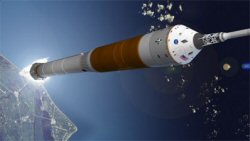
A single
space shuttle solid rocket booster might be used to transport the
new astronaut capsule into space.
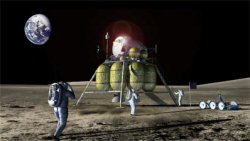
Credits: NASA/John Frassanito and Associates
|
NASA's new
bid for the Moon
BBC
News World Edition: 19
September 2005
NASA recently
announced that they are planning to send humans back to the Moon
by 2018. The cost might be close to R700 billion.
NASA sent nine manned missions to the Moon Between 1968 and 1972
and 12 men walked on its surface during that time.
The lunar return project aims to someday use the moon as a staging
post for missions to the planet Mars and beyond. The possibility
exists that NASA may build a semi-permanent lunar base, where astronauts
can make use of the Moon's natural resources for water and fuel.
Two moon flights per year are currently envisioned.
The current space shuttle is to be retired by 2010. It will be replaced
by the Crew Exploration Vehicle (CEV) to be ready by 2012.
The CEV will be shaped like the Apollo command and service modules
and will be able to take four astronauts to the Moon at a time.
Full article: http://news.bbc.co.uk/2/hi/science/nature/4261522.stm
|
|
2. Astronomy news from around the world
|
|
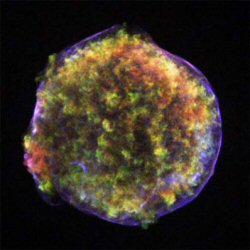
Tycho's supernova
remnant (exploded star).
The blue outer
layer represents rapidly moving, extremely high energy electrons.
Credit: NASA/CXC/Rutgers/J.Warren &
J.Hughes et al
|
Chandra's
Evidence for Cosmic Rays
Chandra
Observatory News Release: 22 September 2005
In
1572, the Danish astronomer Tycho Brahe observed the explosion of
a star that was later named "Tycho's supernova". The Chandra Observatory (satellite
in orbit around Earth) captured an image of the supernova which
shows "an expanding bubble of multimillion degree debris
(green and red) inside a more rapidly moving shell of extremely
high energy electrons (filamentary blue)" - see image at
left.
Two X-ray emitting shock waves are created by fast expanding stellar
debris - one moves outward into the interstellar gas, and another
moves back into the debris.
Chandra's observation is important in understanding the origin of
"cosmic rays". These rays are high-energy atomic nuclei
which pervade the Galaxy and also constantly bombard the Earth.
Proposed sources of cosmic rays include e.g. solar flares and similar
events on other stars, pulsars, and black hole accretion disks.
The prime suspect however - supernova shock waves. And Chandra's
"Tycho" findings strengthen the case.
From article at: http://chandra.harvard.edu/photo/2005/tycho/
|
|
3. Interesting Space Facts
|
|
- Supernovae: Supernovae are immensely energetic explosions
which can be as bright as a whole galaxy. Supernovae occurs when
a very big star comes to the end of its lifetime. The star's nuclear
fuel (hydrogen) becomes exhausted and helium is left to undergo
fusion. Later, even heavier elements undergo this process. Layers
of gas are thrown off into space. The expanding core and rushing
layers collide with each other as the star expand and contract,
giving of a tremendous shockwave. The layers are blown away from
the core and causes the supernova's mammoth explosion. The remaining
matter might form a neutron star or even a black hole.
- White dwarfs: Our sun is too small to become a supernova.
In about 5 billion years, our sun's hydrogen supply will become
depleted.
After becoming a red giant for some time, engulfing all the inner
rocky planets, it will contract to become a white dwarf star, shining
faintly and being surrounded by a cloud of nebulous gas thrown off
in the process. It will form a planetary nebula.
|
|
What is a
so-called "Wormhole"?
No, it's
not only an earthworm's hole in your vegetable garden. In astronomy
there is also a term "wormhole", albeit with a different
interpretation and more sci-fi at the moment than anything else.
By using some accepted models of "general relativity"
theory you can bend the fabric of local space-time geometry by utilizing
an extremely strong gravitational field. The space-time fabric becomes
so intensely warped that it folds in on itself and can perhaps create
a connection to a different location in space or time. These "connections"
are referred to as wormholes. This concept may one day be
used for quicker movement between stars. Someday artificial wormholes
might be produced which can be large enough and remain open long
enough for a traveller to pass through. Hope I don't come out somewhere
in the middle of the hot dry waterless Gobi desert!
More
at BBC Science:
http://www.bbc.co.uk/science/space/deepspace/wormholes/
|
____________________________________________________________________________________________________________________________
|

Image of the Sun
with sunspots visible. Credit: Jacques van Delft,
ASSA Bloemfontein Centre.
|
What
are stars made of?
As
you know, the stars that we can see are nothing else than "suns".
Our Sun is in turn nothing more than an ordinary mid-life, mid-size
star. Our Sun, like other stars that we can see, formed in a huge
gas clouds consisting almost entirely of hydrogen atoms. These "birth-places"
of stars are called nebulae. Many beautiful nebulae can be seen
through modest telescopes and some can be observed using binoculars
or even your naked eyes.
Over 90% of our sun consists of hydrogen. The rest (almost 8%) consists
of mainly helium. A very small percentage is made up of heavier
elements like oxygen, carbon, nitrogen etc. Thus, stars are "huge
balls of burning gas in space"!
Solar
composition summary:
http://www.earth.uni.edu/~morgan/astro/course/Notes/section2/solarcomp.html
Doing your own solar observations safely: http://www.geocities.com/jjvdelft1/solar.html
|
|
Currently
low in the western sky is the planet Jupiter, flanked to
the upper left by the star Spica (alpha Virginis). Venus
shines very bright a few degrees above them.
At 20h00, South African observers will see a bright star shining
just above the northern horizon, slightly to the west. This star
is called Vega - alpha Lyrae. Vega is the 5th brightest star
in the sky. It is also one of the nearest stars to our sun
- only 26 light years away!
The constellation of Pegasus (the Winged Horse) is rising
in the east with Spring. Watch for the Square of Pegasus later in
the evening - a giant square forming the body of the horse, with
its head pointing west.
Amateur astronomers with medium-sized telescopes can do themselves
a favour and still try to observe the open cluster M11, also
known as the Wild Duck cluster in Scutum. A bit difficult
to find first time, but surprisingly beautiful. At small magnifications
it appears to take on the form of a globular star cluster.
See a picture of M11 on APOD: http://antwrp.gsfc.nasa.gov/apod/ap030122.html
Chances are running out to catch a last glimpse of Scorpius and
Sagittarius. Binocular users in dark skies can scan
these constellations and see what deep sky objects you can find.
More on deep sky observing on the national ASSA Deep Sky
pages: http://www.saao.ac.za/assa/html/32_deepsky.html
|
|
|
6. Amateur Astronomers' Corner
|
|
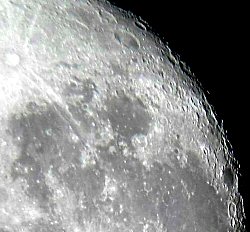
Part of a full
disk photo of the moon, taken by Neels Raath (ASSA Bloemfontein
Centre), using a Sony W15 digital through a 10 inch Dobsonian with a 25 mm eyepiece.
|
Photographing
lunar details
Many
people unacquainted with telescopes are amazed when the see they
can take impressive pictures of the moon's surface by using their
ordinary digital cameras. With the right telescope (even
some small ones) and the right size eyepiece, you can turn your
digital camera into a handy astrophotographer tool. The moon
is an easy target, because it is bright enough to not worry about
exposure times and holding your hands steady if you don't have a
camera adapter to fit on your telescope.
You can edit your photo afterwards with image processing
software like Paint Shop Pro or Photoshop etc. Try
increasing the photo's "contrast" and you will see the
boundaries between the detail on the photo coming out superbly (this
is also true for ordinary land photos - colours are "contrasted"
against each other and the image becomes clearer). You can
even compare your lunar photo with a lunar map and see which craters
you can make out on your own photo.
|
|
7. Astronomy in Southern Africa
|
|
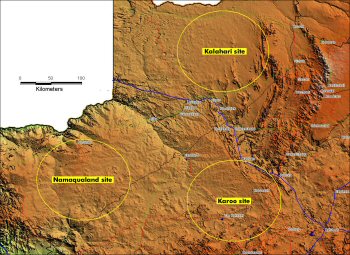
Digital elevation map showing proposed sites for the SKA: in Namaqualand,
the Kalahari or Karoo. SKA.
|
SA's bid for
the Square Kilometer Array
SKA
website
South
Africa's near-perfect locations for astronomical observations in
certain parts of the country makes it the ideal place to host large
international observatories, visual or radio.
The Square Kilometer Array is one of the most exciting radio
astronomy projects in decades and aims "to create a
receiving surface of a million square metres - one hundred times
larger than the biggest receiving surface now in existence".
South Africa is in on the race to be the host country
of the project.
The SKA will
consists of many small antennas spread out over a vast area of land.
The signals received by each of the smaller antennas will be combined
to form a single, big, picture.
From
the SKA website. More information: : http://www.ska.ac.za/
|
For other SA
Astronomy websites, go to the SpaceTides SA Astronomy Portal
at:
www.assabfn.co.za/spacetides/sa_astronomy.htm
|
8. Astronomy Events in the City of Bloemfontein
|
The different
astronomy organisations in the City, working hand-in-hand to inform
people about the interesting
world of astronomy and spaceflight,
can be reached at the following contact details:
|

|
Explore Boyden Observatory:
www.assabfn.co.za/friendsofboyden/explore.htm
One
of the most publicly accessible observatories of its kind in the
Southern Hemisphere, also housing SA's third largest telescope.
To arrange group visits to the Observatory, phone Dr. Matie Hoffman
at 051-401 2924 for more information, or send an e-mail to him at:
HoffmaMJ.SCI@mail.uovs.ac.za
Next Boyden Open Evening/Volgende
Boyden Ope-aand: (Bloemfontein,
SA) - Saturday 5 November 2005, 18h30 for 19h00. International Astronomer
from the University of Michigan in the USA, Dr. Patrick Seitzer
will give a 15 minute talk on the Lamont-Hussey Observatory and
give a presentation on the exciting topic of space debris called
"When Good Satellites Go Bad - An Astronomical Survey for
Space Debris". Observations of deep sky objects through
telescopes. Please watch the media for reservation details.
|
|

|
The
Friends of Boyden: www.assabfn.co.za/friendsofboyden
A public interest group for Boyden Observatory and for people
interested in joining the astronomical community of Bloemfontein,
but not make astronomy necessarily their "full-time" hobby.
Contact Braam van Zyl at 051-436 7555 (h) or visit the website above
for more information regarding the Friends. Anyone can become a
member. R50 membership fee per year for a whole family. Members
receive the latest information on astronomy events in Bloem, attend
the Friends' presentations free of charge and receive the "Naghemel"
quarterly newsletter compiled by ASSA Bloemfontein by post.
|
|

|
ASSA
Bloemfontein
Centre: www.assabfn.co.za
Affiliated with the Astronomical Society of Southern Africa, the
Bloemfontein Centre of ASSA is an active organization of amateur
astronomers meeting on a regular basis to discuss and practise astronomy
as hobby. Activities include solar-, lunar-, deep sky- and comet
& meteor observations, as well as historical research, telescope
building, tours and away-weekends under dark skies. Send an e-mail
to mail@assabfn.co.za or
visit the website. Interested persons can also contact Phillip Coetzer:
084 627 7626.
|
Onthou ook om Boyden Sterrewag se gereelde sterrekunde berigte
in die "Ons Stad" plaaslike koerant te lees.
Dit bevat ook meer inligting rakende Boyden besoektye.
SpaceTides is a free internet e-zine for persons interested in expanding their
general knowledge of astronomy and spaceflight.
The e-zine originates from the City of Bloemfontein in South Africa and
is compiled us a service to the public by ASSA Bloemfontein Centre
as part of their educational outreach activities. Website: www.assabfn.co.za.
SpaceTides contains links to various other third party sites on the
internet, not always connected to SpaceTides. The persons and entities
responsible
for compiling SpaceTides will not be held responsible for the content
or information on these third party sites or any damage of any kind
incurred from
downloading, opening, or viewing anything from/through these sites.
If you would like to unsubscribe from SpaceTides, send an e-mail
to spacetides@assabfn.co.za with the word
"Unsubscribe" in the subject line.
|



